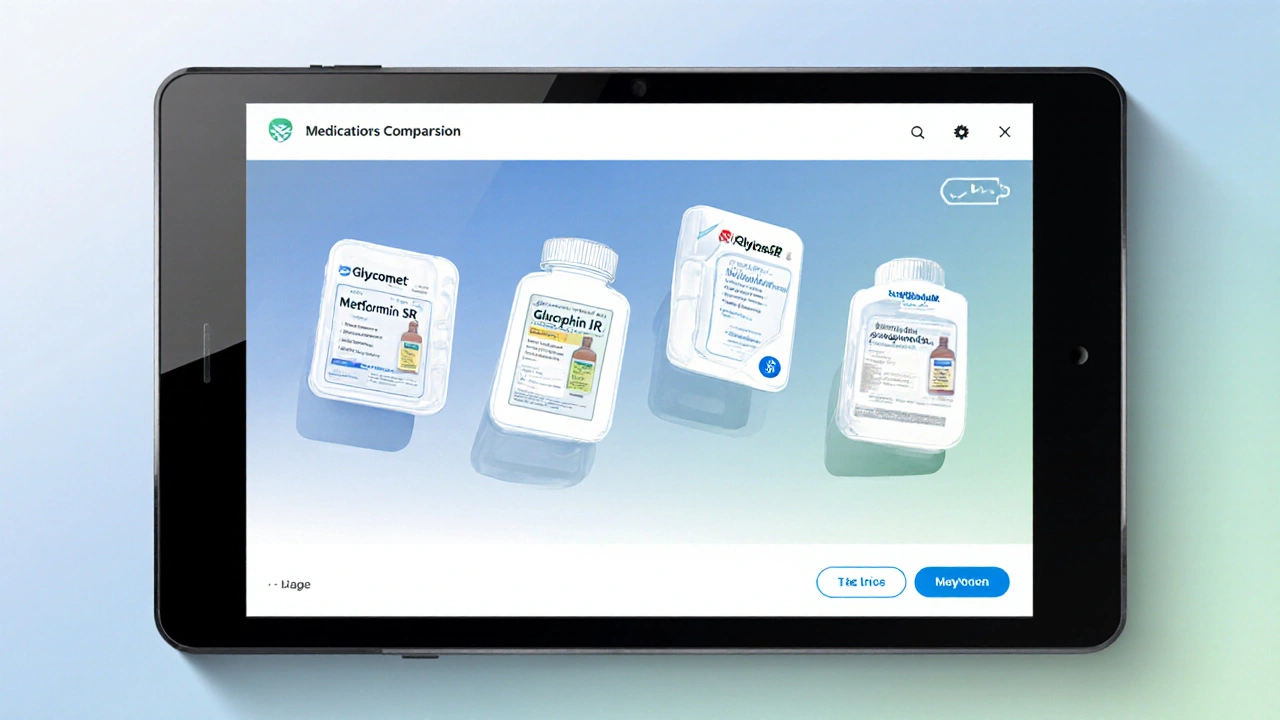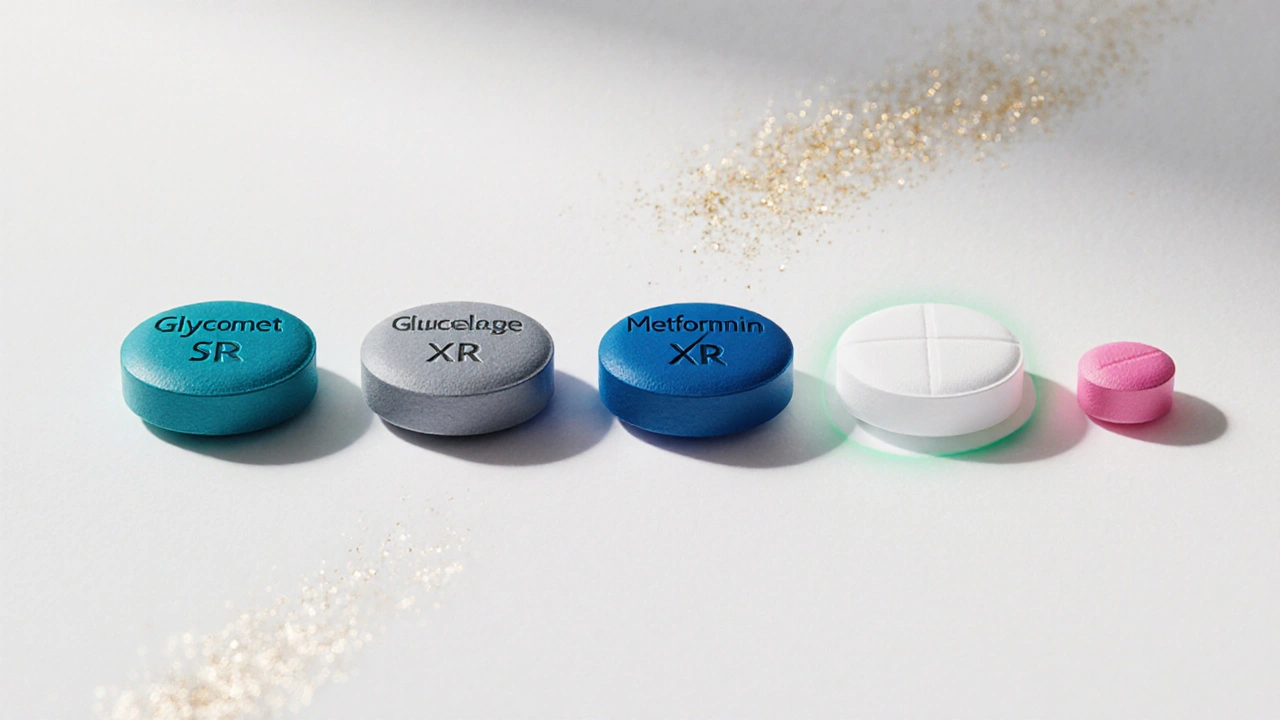Glycomet SR vs Other Metformin Options: A Detailed Comparison

Metformin Formulation Comparison Tool
Use this tool to compare Glycomet SR against other metformin formulations based on:
- Cost - Out-of-pocket price
- Efficacy - Average HbA1c reduction
- Dosing Convenience - Frequency and flexibility
- Side-effect Profile - GI tolerance and risks
- Renal Safety - Maximum eGFR limits
| Product | Formulation | Dosage | Cost (CAD/tablet) | HbA1c Reduction | GI Tolerance | eGFR Limit |
|---|---|---|---|---|---|---|
| Glycomet SR | Extended-release matrix | 500 mg - 850 mg once daily | $0.45 - $0.78 | ≈1.0% | Improved vs IR (~30% fewer GI events) | >45 mL/min/1.73 m² |
| Generic Metformin SR | Extended-release, non-branded | 500 mg - 850 mg once daily | $0.30 - $0.55 | ≈1.0% | Similar to Glycomet SR | >45 mL/min/1.73 m² |
| Glucophage XR | Extended-release, patented | 500 mg - 1000 mg once daily | $0.60 - $0.90 | ≈1.1% | Very good GI profile | >30 mL/min/1.73 m² |
| Metformin IR | Immediate-release tablet | 500 mg 2-3 times daily | $0.20 - $0.35 | ≈0.9% | Higher GI events (~45% report nausea) | >30 mL/min/1.73 m² |
Glycomet SR is a Canadian branded extended-release metformin tablet with a patented 24-hour release profile. Its formulation uses a polymer-based coating that minimizes peaks in blood concentration, reducing gastrointestinal side effects.
Dosage: Available in 500 mg and 850 mg tablets
Administration: Once daily with the evening meal
Cost: CAD $0.45 per 500 mg tablet (2025 average retail)
TL;DR
- Glycomet SR is a Canadian branded extended‑release metformin tablet with a patented 24‑hour release profile.
- Its price sits between generic SR metformin and premium brands like Glucophage XR.
- Side‑effect profile is similar to other metformin forms, but once‑daily dosing improves GI tolerance for many patients.
- For patients who need tighter glucose control or have contraindications to metformin, add‑on agents such as sitagliptin or empagliflozin are worth considering.
- Choosing the right option depends on cost, dosing convenience, renal function, and personal tolerance.
When it comes to managing type‑2 diabetes, Glycomet SR often pops up in pharmacy aisles across Canada. But is it really the best choice, or are there cheaper or more effective alternatives? This article breaks down the key differences between Glycomet SR and other metformin formulations, plus a few non‑metformin options, so you can decide what fits your health goals and budget.
Glycomet SR is a brand‑name extended‑release metformin tablet marketed in Canada, produced by Lupin Pharmaceuticals.
What Is Glycomet SR?
Glycomet SR (Sustained Release) contains 500mg or 850mg of metformin hydrochloride in a matrix that releases the drug slowly over about 24hours. The formulation uses a polymer‑based coating that minimizes peaks in blood concentration, which can reduce the notorious gastrointestinal (GI) side effects that plague immediate‑release (IR) metformin.
Key attributes:
- Dosage forms: 500mg, 850mg tablets
- Administration: once daily with the evening meal
- Regulatory status: Health Canada‑approved prescription drug
- Cost (2025 average retail): CAD$0.45 per 500mg tablet
How Extended‑Release Metformin Works
Metformin, regardless of brand, belongs to the biguanide class. It lowers hepatic glucose production, improves peripheral insulin sensitivity, and modestly reduces appetite. The SR version spreads the drug’s release throughout the day, keeping plasma levels more stable. This steadier curve gives two practical benefits:
- Fewer GI complaints (nausea, diarrhea) because the intestine isn’t hit with a large bolus.
- Convenient once‑daily dosing, which improves adherence for patients who struggle with the three‑times‑daily schedule of IR metformin.
Metformin is a biguanide oral antihyperglycemic agent used as first‑line therapy for type‑2 diabetes.
Choosing Comparison Criteria
To decide whether Glycomet SR is right for you, we’ll look at five practical dimensions that matter to most patients and prescribers:
- Cost - out‑of‑pocket price and insurance coverage.
- Efficacy - average HbA1c reduction in clinical trials.
- Dosing convenience - frequency and flexibility.
- Side‑effect profile - especially GI tolerance and rare lactic acidosis risk.
- Renal safety - maximum eGFR limits for each formulation.

Direct Comparison Table
| Product | Formulation | Typical Dose | Cost (CAD per tablet) | HbA1c reduction* | GI tolerance | eGFR limit |
|---|---|---|---|---|---|---|
| Glycomet SR | Extended‑release matrix | 500mg - 850mg once daily | 0.45 - 0.78 | ≈1.0% | Improved vs IR (≈30% fewer GI events) | >45mL/min/1.73m² |
| Generic Metformin SR | Extended‑release, non‑branded | 500mg - 850mg once daily | 0.30 - 0.55 | ≈1.0% | Similar to Glycomet SR | >45mL/min/1.73m² |
| Glucophage XR | Extended‑release, patented | 500mg - 1000mg once daily | 0.60 - 0.90 | ≈1.1% | Very good GI profile | >30mL/min/1.73m² |
| Metformin IR | Immediate‑release tablet | 500mg 2-3 times daily | 0.20 - 0.35 | ≈0.9% | Higher GI events (≈45% report nausea) | >30mL/min/1.73m² |
| Sitagliptin | DPP‑4 inhibitor (non‑metformin) | 100mg once daily | 1.20 - 1.50 | ≈0.6% | Very low GI impact | Any eGFR (dose‑adjusted if <45) |
*Based on average reductions reported in PhaseIII trials and meta‑analyses up to 2024.
Pros and Cons of Each Option
Glycomet SR
- Pros: once‑daily dosing, solid GI tolerance, brand‑level consistency, covered by most provincial formularies.
- Cons: slightly pricier than generic SR, limited to 500mg & 850mg strengths (no 1000mg option).
Generic Metformin SR
- Pros: lower cost, same pharmacokinetics as Glycomet SR.
- Cons: variability in tablet coating quality across manufacturers; some patients report occasional GI spikes.
Glucophage XR
- Pros: highest dose (1000mg) available in a single tablet, excellent GI profile, strong brand reputation.
- Cons: highest price among SR options; not always listed on provincial drug plans.
Metformin IR
- Pros: cheapest metformin, flexible dosing (can split doses).
- Cons: multiple daily doses, higher incidence of stomach upset, may affect adherence.
Sitagliptin (non‑metformin)
- Pros: low hypoglycemia risk, easy once‑daily pill, works well when metformin is contraindicated (e.g., severe renal impairment).
- Cons: modest HbA1c drop, highest out‑of‑pocket cost, not first‑line per ADA 2025 guidelines.
Who Should Consider Glycomet SR?
If you fit any of the following, Glycomet SR might be the sweet spot:
- Newly diagnosed type‑2 diabetes patients who need a steady metformin effect but struggle with three‑times‑daily pills.
- Patients with mild to moderate GI sensitivity who have tried IR metformin without success.
- Those whose provincial drug plan lists Glycomet SR as a preferred brand, keeping copays low.
- Individuals with eGFR>45mL/min/1.73m² who want to avoid dose‑adjustments that are needed for some SR brands.
Conversely, if you have a very low eGFR (<30) or need a higher maximum dose than 850mg, a switch to Glucophage XR or an add‑on agent like sitagliptin may be safer.
Practical Tips for Switching or Starting
- Consult your prescriber before changing brands; they’ll check kidney function and recent HbA1c.
- If moving from IR to SR, the usual conversion is 1:1 (e.g., 500mg IR BID → 1000mg SR once daily).
- Take the SR tablet with the largest meal of the day to minimise GI upset.
- Monitor blood glucose for the first two weeks; adjust dose only after stable readings.
- Report any persistent nausea, vomiting, or lactic‑acidosis symptoms (e.g., rapid breathing, muscle pain) to a clinician immediately.
Key Takeaway
Glycomet SR offers the convenience of once‑daily dosing and a smoother GI profile without sacrificing the proven HbA1c‑lowering power of metformin. It sits in the middle of the cost‑effectiveness curve-cheaper than premium brands like Glucophage XR but pricier than generic SR options. Your final choice should align with personal tolerance, renal health, and insurance coverage.

Frequently Asked Questions
Can I take Glycomet SR with other diabetes medications?
Yes. Glycomet SR is often combined with sulfonylureas, SGLT2 inhibitors, or DPP‑4 inhibitors when a single drug doesn’t meet the HbA1c target. Your doctor will adjust doses to avoid hypoglycemia.
Is Glycomet SR safe during pregnancy?
Metformin, including SR forms, is classified as Category B in Canada, meaning animal studies show no risk and there are no well‑controlled studies in pregnant women. Many clinicians continue it if benefits outweigh potential risks, but you must discuss it with your obstetrician.
How does Glycomet SR compare to Glucophage XR in terms of kidney safety?
Both are SR metformin, but Glucophage XR is approved down to an eGFR of 30mL/min/1.73m², while Glycomet SR follows the stricter >45mL/min guideline in most provincial formularies. If your kidney function is borderline, Glucophage XR may be the safer pick.
Will switching to Glycomet SR reduce my pill burden?
Absolutely. Most patients on IR metformin take 2-3 tablets daily. Glycomet SR collapses that schedule into a single evening tablet, which studies show improves adherence by roughly 15%.
What should I do if I miss a dose of Glycomet SR?
Take the missed tablet as soon as you remember, unless it’s within 12hours of the next scheduled dose. In that case, skip the missed pill and continue with your regular schedule. Do not double up.
When one peruses the refined tableau of metformin options, the allure of a branded, patented release system becomes almost cinematic. The Glycomet SR, with its glossy packaging and patented polymer matrix, whispers exclusivity to the discerning patient. Its cost, hovering between the modest generic and the lofty Glucophage XR, positions it as the middle‑child of the pharmacopeia, demanding both admiration and a sigh of fiscal responsibility. Yet beyond the numbers, the very act of swallowing a single, elegant tablet each evening evokes a ritualistic grace absent from the clattering regimen of thrice‑daily IR doses. In the grand theatre of diabetes management, Glycomet SR plays the protagonist with a flair that mere generics can only envy.
It is with a measured deliberation that I examine the comparative metrics presented for the various metformin formulations, endeavoring to elucidate the nuanced distinctions that may elude a cursory perusal. Firstly, the fiscal considerations merit a comprehensive appraisal, for the disparity between $0.30 per generic SR tablet and $0.90 per Glucophage XR tablet constitutes a non‑trivial variance in cumulative expenditure over a twelve‑month horizon. Secondly, the pharmacodynamic efficacy, as quantified by mean HbA1c reduction, demonstrates a marginal superiority of Glucophage XR at approximately 1.1 percent relative to the 1.0 percent observed with both Glycomet SR and its generic counterpart; such a differential, while statistically modest, may bear clinical relevance in patients hovering near therapeutic thresholds. Thirdly, the dosing convenience, an oft‑overlooked determinant of adherence, favours the once‑daily extended‑release preparations, thereby mitigating the regimen fatigue commonly associated with immediate‑release dosing schedules. Fourthly, the gastrointestinal tolerability profile, a pivotal factor influencing patient satisfaction, is ostensibly ameliorated in the extended‑release matrices, with an estimated 30 percent reduction in adverse events relative to immediate‑release formulations. Fifthly, the renal safety parameters, delineated by the minimal eGFR thresholds, reveal that Glycomet SR and generic SR maintain eligibility down to an eGFR of 45 mL/min/1.73 m², whereas Glucophage XR extends this permissibility to 30 mL/min/1.73 m², thereby accommodating a broader spectrum of patients with compromised renal function. Sixthly, the regulatory provenance of the branded Glycomet SR, sanctioned by Health Canada, may impart an additional layer of confidence regarding manufacturing consistency and bioequivalence. Seventhly, the pharmacokinetic constancy conferred by the matrix‑controlled release engenders a more stable plasma concentration curve, a factor of particular import in minimizing peak‑related adverse effects. Eighthly, the ancillary considerations of ancillary therapy, such as the potential need for co‑prescription of incretin‑based agents, should be weighed against the baseline efficacy achieved by each formulation. Ninthly, patient preference surveys routinely underscore a predilection for reduced pill burden, a desideratum unequivocally satisfied by the single‑tablet daily regimen of the extended‑release products. Tenthly, the environmental impact of pharmaceutical packaging, albeit peripheral, may merit contemplation in the era of sustainable healthcare practices. Eleventh, the socioeconomic stratification of patient populations underscores the necessity of aligning therapeutic choice with both clinical efficacy and economic feasibility. Twelfth, the insurance formularies across provincial jurisdictions frequently delineate tiered copayment structures that may render the generic SR the most cost‑effective option for the majority of beneficiaries. Thirteenth, the potential for medication errors diminishes concomitantly with the simplification of dosing frequency, thereby enhancing overall safety. Fourteenth, the longitudinal data pertaining to cardiovascular outcomes, while not yet definitively conclusive, suggest a neutral to modestly beneficial profile across all metformin formulations. Finally, it is incumbent upon the prescriber to integrate these multifactorial considerations within a shared decision‑making framework, thereby honoring both the scientific rigor and the individual patient’s lived experience.
Hey folks, just wanted to point out that the eGFR cutoff really matters when picking a metformin. If your kidney function is above 45, you’re good to go with Glycomet SR or the generic SR. Below that, you might need to look at Glucophage XR, which lets you stay above 30. Also, taking the tablet with your evening meal can help smooth out any stomach upset. It’s worth checking if your insurance covers the brand or if the generic gives you the same outcome for less cash.